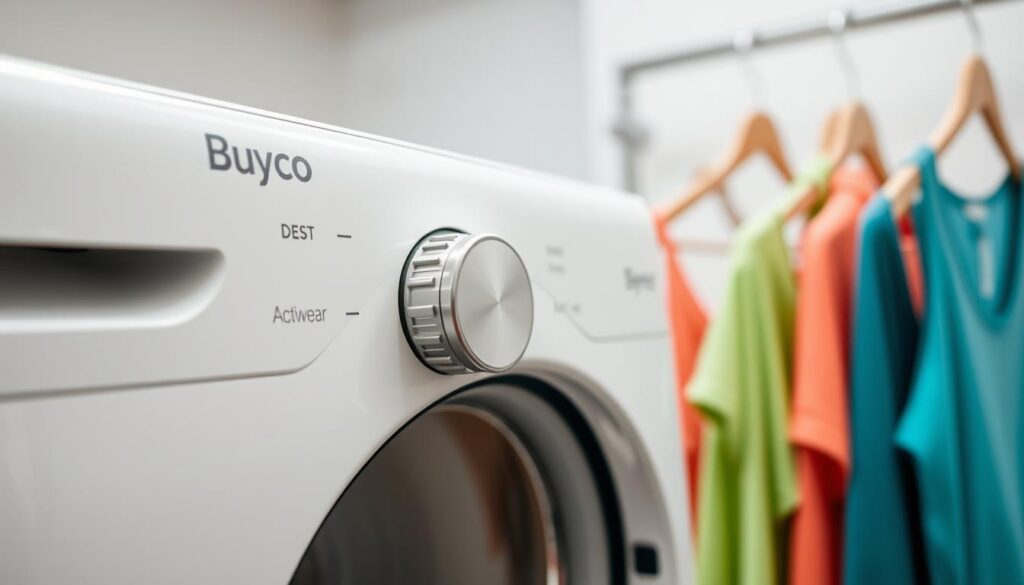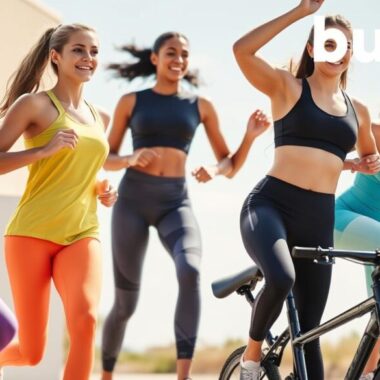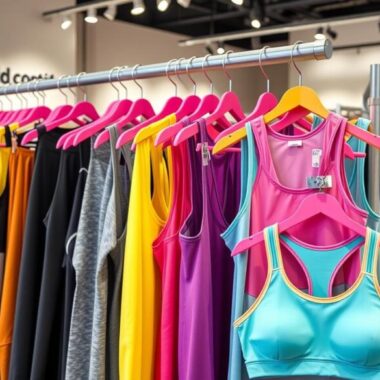I love working out and finding the best activewear to keep me comfy and confident. But, I’ve always wondered if I can just toss it in the dryer. In this article, I’ll share expert tips on how to dry activewear right. This way, your favorite workout clothes will stay in top shape for years.
Key Takeaways
- Proper drying techniques are crucial for preserving the quality and longevity of activewear.
- Not all activewear fabrics can withstand the high heat of a traditional clothes dryer.
- Identifying the fabric type and following care label instructions is essential for safe drying.
- Certain fabrics, like polyester and spandex, require special drying precautions to prevent shrinkage or damage.
- Exploring alternative drying methods, such as air drying or low-heat settings, can help protect delicate activewear.
Introduction to Activewear Drying
Keeping your activewear in great shape is key. It includes workout clothes like tops, leggings, and sports bras. These items need special care to stay good for working out. We’ll talk about why drying them right is important and what to keep in mind.
What is Activewear?
Activewear is clothing made for working out, sports, and fitness. It’s usually made from synthetic materials like polyester, nylon, and spandex. These fabrics help keep you cool and comfortable while you’re active.
Importance of Proper Drying Techniques
- Maintains fabric performance: Right drying keeps activewear’s moisture-wicking and breathable qualities. This ensures your clothes work well during exercise.
- Prevents fabric damage: Wrong drying can cause shrinkage, fading, and damage to the fabric. This shortens your activewear’s life.
- Maintains fit and shape: Correct drying helps your activewear keep its shape and fit. This prevents it from stretching or sagging.
- Enhances longevity: Following the right drying tips can make your activewear last longer. This means you get more use out of your clothes.
We’ll explore more about can you put activewear in the dryer, activewear drying guidelines, and drying synthetic fabrics. This will help keep your workout clothes in the best condition.
Can You Put Activewear in the Dryer?
Whether you can dry activewear in the machine isn’t a simple yes or no. It depends on the fabric and the care instructions. Some activewear can be machine dried, but others need gentle care to avoid damage.
Activewear is made to wick away moisture and breathe well. This means its fabrics can’t handle high heat like cotton. Wrong drying methods can harm your activewear’s performance and lifespan. Always follow the manufacturer’s care guidelines.
Checking Care Labels
To see if you can dry your activewear in the machine, check the care label. Look for drying instructions, temperature settings, and any special care tips. Following these will help keep your activewear looking and feeling great.
Identifying Fabric Types
It’s also key to know the fabrics in your activewear. Materials like polyester, nylon, and spandex can handle dryer heat. But fabrics like wool or some synthetic blends need air drying or a gentle cycle.
| Fabric Type | Dryer Suitability |
|---|---|
| Polyester | Can be dried in the dryer on a low or delicate setting |
| Nylon | Can be dried in the dryer on a low or delicate setting |
| Spandex | Can be dried in the dryer on a low or delicate setting |
| Wool | Should be air dried to prevent shrinkage |
| Synthetic Blends | May require air drying or a delicate drying cycle |
Knowing the right care for your activewear helps keep it in top shape. This way, you can enjoy its performance and look for longer.
Activewear Drying Guidelines
When drying activewear, always follow the care label instructions. These guidelines tell you the best way to dry, the temperature, and any special tips. Knowing your activewear’s fabric is also key. It helps keep your clothes looking good and working well.
Checking Care Labels
Care labels are crucial for taking care of your activewear. They show the right way to wash and dry your clothes. Reading the label helps prevent damage and makes your activewear last longer.
Identifying Fabric Types
Activewear is made from synthetic fabrics like polyester, nylon, and spandex. Each fabric needs a different drying method. You can find this info on the care label or product details.
| Fabric Type | Drying Recommendations |
|---|---|
| Polyester | Tumble dry on low heat |
| Nylon | Tumble dry on low heat or air dry |
| Spandex | Air dry or lay flat to dry |
By following these guidelines and knowing your fabric, your activewear will stay in top shape. It will keep performing well and looking great for a longer time.
Drying Synthetic Fabrics
Drying activewear made from synthetic fabrics like polyester, nylon, or spandex needs special care. These materials are delicate and can get damaged, shrink, or lose their performance if not dried right.
To keep your synthetic activewear in top shape, follow these drying tips:
- Check the care label. Always look at the manufacturer’s drying instructions. They will tell you the right temperature and cycle for your synthetic fabrics.
- Avoid high heat. High heat can shrink, distort, or even melt synthetic fibers. Choose a low or delicate drying cycle. Or, line dry your activewear when you can.
- Separate by fabric type. Dry your activewear by fabric type, like polyester, nylon, or spandex. This prevents damage from hotter or rougher cycles.
- Fluff and refresh. Use a low heat setting or air fluff cycle to gently tumble dry your synthetic activewear. This helps restore its shape and softness.
By following these simple drying guidelines for synthetic fabrics, you can make your activewear last longer. It will also keep looking and feeling great for many workouts ahead.
Heat-Safe Activewear
Not all fabrics dry the same way. Polyester, found in many activewear items, can handle high temperatures. This means you can usually dry it on your machine’s standard heat settings. This is different from fabrics like spandex, which need gentler care.
Polyester Drying Tips
Here are some tips for drying polyester activewear:
- Use a regular, high-heat drying cycle. Polyester can handle high temperatures without damage or shrinkage.
- Avoid delicate or air-dry cycles. They’re better for fragile fabrics and might not dry polyester fully.
- Always check the care label. Some polyester items might have special drying needs.
- Wash and dry polyester items together. This ensures they get the same heat and dry time.
By following these tips, your polyester activewear will stay in great shape. It will look and feel good, wash after wash.
| Fabric Type | Drying Recommendation |
|---|---|
| Polyester | High heat |
| Spandex | Low heat or air dry |
| Cotton | Medium heat |
| Nylon | High heat |
Dryer Settings for Activewear
Choosing the right dryer settings is key for your activewear. It keeps your workout gear in great shape. By following the right activewear drying guidelines, your athletic apparel lasts longer and looks better.
It’s important to pick a dryer cycle and temperature that fit your activewear’s fabric and design. Here are some tips for the best dryer settings for activewear:
- Check the care label: Always look at the care instructions from the manufacturer. They tell you the best drying cycle and temperature for your activewear.
- Consider the fabric type: Synthetic fabrics like polyester and nylon can handle higher temperatures. Natural fibers like cotton need a gentler, lower-heat setting to avoid shrinkage or damage.
- Opt for a delicate or low-heat cycle: Most activewear does best with a delicate or low-heat cycle. This prevents over-drying and keeps the fabric in good shape. Avoid high-heat settings, as they can cause shrinkage, fading, or melting of synthetic materials.
- Use the air-dry or low-heat setting: If your dryer has an air-dry or low-heat setting, use it for activewear. This gentle drying method keeps the fabric’s shape and performance without harming the material.
By following these activewear drying guidelines and choosing the right dryer settings, your workout gear stays in top condition. It will perform well for many years.


Activewear Care Instructions
It’s crucial to follow the care labels on your activewear. These labels tell you how to wash and dry your workout clothes. This keeps them looking good and working well.
Spandex Drying Precautions
Spandex is a key material in many activewear items. It makes clothes stretchy and comfy. But, spandex needs special care when drying.
- Don’t dry spandex clothes in high heat. It can damage the fibers and make them lose their stretch.
- Use a low-heat setting or air-dry them. This keeps the fabric in good shape.
- Another option is to lay them flat or hang them to air-dry. This also helps keep the fabric intact.
By following these activewear drying guidelines, you take care of your activewear care instructions. This ensures your spandex-rich clothes last longer and stay comfy.
“Taking the time to properly care for your activewear will not only extend its lifespan but also help it maintain the performance and comfort you’ve come to expect.”
Shrinkage Prevention for Activewear
Preventing shrinkage is key when drying activewear. Using the right drying methods keeps your workout clothes fitting well. This ensures they stay useful for your fitness routines.
To stop shrinkage, always check the activewear drying guidelines on the label. These tips usually cover the best drying methods, temperature, and any special care steps.
- Choose low-heat or air-drying options when you can. High heat can shrink fabrics like spandex.
- Don’t dry activewear with heavy items in the dryer. The weight and movement can cause shrinkage.
- Try hanging or laying flat to dry. This method is gentler on the fabric and keeps your activewear’s shape.
By following these shrinkage prevention steps, your activewear will last longer. You’ll keep the perfect fit and comfort for your workouts.
| Fabric Type | Shrinkage Prevention Tips |
|---|---|
| Polyester | Dry on low heat or air-dry to avoid excessive shrinkage. |
| Spandex | Use low heat settings and avoid over-drying to prevent shrinkage. |
| Nylon | Dry on low heat or line-dry to maintain the fabric’s original size and shape. |
By sticking to these activewear drying guidelines and taking steps to prevent shrinkage, your workout clothes will keep performing. They’ll offer comfort, support, and performance for every workout.


Activewear Drying Temperature
The temperature you choose to dry your activewear is key. It affects how well the fabric works and lasts. Knowing the best temperature range is crucial for keeping your workout clothes in great shape.
Ideal Temperature Range
The best temperature for drying activewear is between 120°F (49°C) and 140°F (60°C). This range is especially important for synthetic fabrics like polyester, nylon, and spandex.
Drying activewear above 140°F (60°C can damage the fabric. It can shrink, pill, and lose its stretch and moisture-wicking abilities. Drying it below 120°F (49°C might not remove moisture well. This can make your clothes damp and prone to mold or mildew.
| Fabric Type | Ideal Drying Temperature |
|---|---|
| Polyester | 120°F (49°C) – 140°F (60°C) |
| Nylon | 120°F (49°C) – 140°F (60°C) |
| Spandex | 120°F (49°C) – 140°F (60°C) |
Sticking to the recommended drying temperature range helps your activewear stay in good condition. This way, you can enjoy your workout clothes for longer and get the best value from them.
Alternative Drying Methods
While dryers are convenient, other methods might be better for activewear. These alternatives can keep your workout clothes in great shape longer.
Air Drying
Air drying is easy and good for the planet. Just hang or lay your clothes flat in a breezy spot. It’s perfect for activewear drying guidelines because it keeps fabrics soft and their shape.
Line Drying
Line drying is similar to air drying but uses a clothesline or rack. It’s great for drying synthetic fabrics because it’s gentle. It also saves energy and is better for the environment.
| Drying Method | Pros | Cons |
|---|---|---|
| Air Drying |
|
|
| Line Drying |
|
|
Alternative drying methods might take longer, but they’re worth it. They make your activewear drying guidelines and drying synthetic fabrics last longer. By trying these methods, your workout clothes will stay in great shape for years.
Conclusion
Whether to dry activewear in the dryer depends on the fabric and care labels. This article has given you tips to keep your workout clothes in great shape. By following these guidelines, your activewear will stay in top condition.
It’s important to check the care labels, especially for synthetic or natural fabrics. The right temperature and drying cycle can help your activewear last longer. Using alternative drying methods can also be beneficial.
Learning how to can you put activewear in the dryer and following the activewear drying guidelines is key. This way, your workout clothes will look and perform well. You can then focus on your fitness goals without worrying about damage.
FAQ
Can you put activewear in the dryer?
Whether you can dry activewear in a dryer depends on the fabric and care label. Always check the label for the best drying method.
What are the key considerations when drying activewear?
To dry activewear right, follow the care label’s instructions. It will tell you the best way to dry, temperature, and any special tips. Knowing your activewear’s fabric is also key to drying it well.
How should I dry synthetic activewear fabrics?
Synthetic fabrics like polyester and nylon need special care when drying. They can shrink or lose their shape if not dried correctly. Always use the recommended drying method for synthetic activewear.
What dryer settings are best for activewear?
The right dryer settings are important to keep activewear in good shape. I’ll show you the best temperature and cycle settings to keep your workout clothes performing well.
What are the key activewear care instructions I should follow?
Besides drying, following all care instructions for activewear is crucial. This includes drying spandex items carefully to avoid shrinkage and keep your clothes fitting right.
How can I prevent shrinkage when drying activewear?
Shrinkage is a big worry when drying activewear. I’ll share tips to prevent it and keep your workout clothes fitting well, so they continue to perform as expected.
What is the ideal drying temperature for activewear?
The drying temperature affects activewear’s performance and lifespan. I’ll suggest the best temperature range to keep your workout clothes in great condition.
Are there any alternative drying methods for activewear?
While dryers are convenient, some activewear fabrics do better with other drying methods. I’ll look at air drying and line drying, and why they might be better for your workout clothes.





